Addiction to Psychoactive Prescription Drugs: Can the Excipients of the Formulations Play a Role?
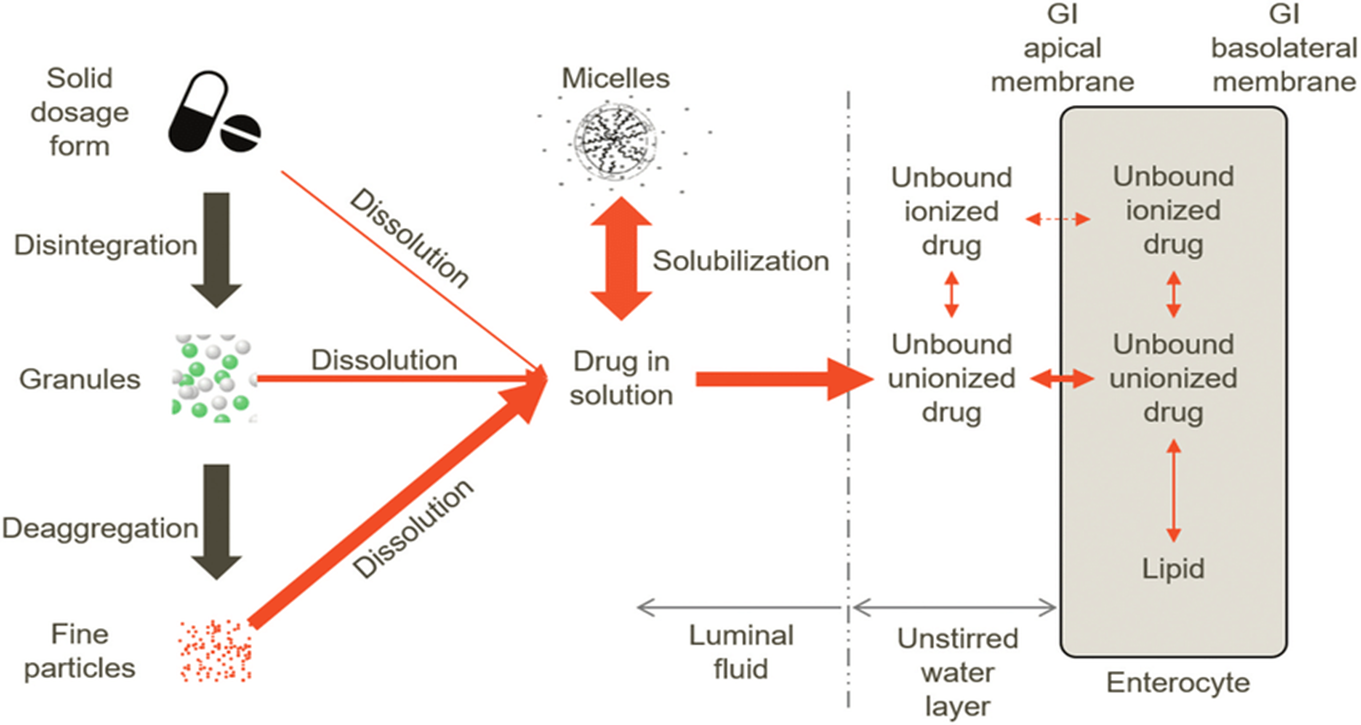
Abstract
In the development of drugs misuse and addiction, references are often made to the study of the API (active principle ingredient) as the main cause, which is certainly true, but there is a tendency to overlook the possible role of certain excipients which may be involved in the preferential development of certain formulations, especially in the case of benzodiazepines and opioids and other psychoactive legal drugs. In this article, we will try to describe the reasons why some excipients can be involved in this phenomenon, briefly describing their main characteristics and evaluating both how they can affect the biopharmaceuticals of the active ingredient and how they can specifically be involved in the development of addiction.
Introduction
Prescription drug abuse is a widespread phenomenon around the world, especially when it comes to psychoactive drugs. In fact, by definition, abuse/dependence develops in the context of the use of drugs that have euphoric, anxiolytic pharmacological properties, and which mediate a positive reinforcement-gratification, activating, more or less directly, the mesolimbic dopaminergic reward circuits.[1] Consequently, drugs such as opioids, benzodiazepines but also, in general, substances with an exciting action (amphetamines, stimulants) or depressants (antidepressants, antiepileptics, GABA-pentinoids, muscle relaxants, antihistamines, some antipsychotics such as quetiapine in the fast formulation) have been associated with diversion , misuse and abuse and, in some subjects, the development of craving, tolerance and addiction.[2]
Various classes of drugs are subject to misuse, including thyroid preparations, doping drugs like anabolic steroids, diuretics, erythropoietin, beta 2 agonists… but the mainly drugs involved to abuse behaviors are those that specifically can induce psychological addiction and physical dependence and tolerance, like some classes of psychoactive drugs. Undoubtedly the nature of the API ( active pharmaceutical ingredient), with its pharmacodynamic/kinetic characteristics, is the main cause of the possible development of this phenomenon.[3] However, the possible role of some particular pharmaceutical formulation and excipients is often overlooked. In fact it should be remembered that an active ingredient is never administered and formulated as such but always in association with excipients to make a specific pharmaceutical form, which are by no means biologically inert as was believed in the past but can influence:
- the method of pharmaceutical production and storage for the shelf life of the drug
- the characteristics of release of the active ingredient (API) and its bioavailability, as well as the route of administration and parameters such as peak effect time and solubility
- aesthetic presentation and palatability, especially for liquid and/or pediatric formulations
In relation to these characteristics it is therefore important to evaluate, in the case of drugs of abuse, also how these factors can influence the probability of developing greater illicit use and how, for example, to intervene in the drug prescription for the cessation of abusers, as many products are available on the market in different pharmaceutical forms.[4]
Excipients: Main Types and Characteristics
The excipients of the pharmaceutical formulations have an important role as the API, generally cannot be administered as such; the formulation allows the patient to receive it in the most appropriate and effective way possible (note that excipients do not cure the disease, but the pharmaceutical preparation cannot do without them!). A general overview is described in Figure 1; they can be classified based on the role:
- constitutive, such as diluents (they give mass to the solid formulation, such as lactose, microcrystalline cellulose, mannitol, starch, sorbitol…) and moisture absorbents (vegetable carbon, starch, glycerin,…)[5]
- role in production such as lubricants (stearic acid), binders (gums, starch, gelatin, hypromellose…), non-stick agents (talc), glidants (flow agents for powder mixtures such as silica derivatives), surfactants (stabilizers for liquid preparations such as tweens, spans, sodium lauryl sulfate…), viscosifiers for suspensions and emulsions…
- role in the release of APIs such as disintegrants for tablets and capsules (starch, alginates…), film-forming release coating polymers (cellulosic derivatives such as acetophthalate, HPMC…) and wetting agents
- role in preservation (benzalkonium, parabens, chlorhexidine, alcohols, etc.), flavoring and sweetening agents (sucrose, saccharin, aspartame, menthol…)[6]
In Figure 2 we see the basic steps of the biopharmaceutical of solid oral drug pharmaceuticals (SODP) and liquid formulations (LODP).
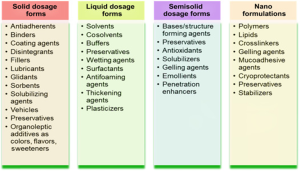
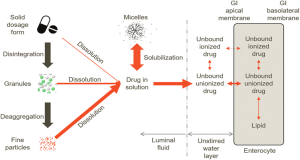
To guarantee the relative steps that allow to obtain a solution from a solid formulation or, if it already was, to keep the drug in liquid form, the excipients become fundamental. Furthermore, they also have the task of not interacting negatively or, if possible, of keeping the chemical identity of the API intact. Many psychoactive drugs are marketed in different formulations, liquid and solid, each of which has advantages and disadvantages over the other. In general we can say that (Figures 3 and 4):
- short acting formulations such as liquid and rapidly absorbed solid formulations (sublingual, oromucosal, buccal, etc.) have a higher potential of abuse[7]
- long acting oral modified formulations, such as film-coated ones, giving levels that are more stable over time and less high, have in themselves less potential for abuse but, if chewed/crushed, they lose this property, releasing a bolus of drug at a very high dose, becoming not only euphoric but potentially toxic
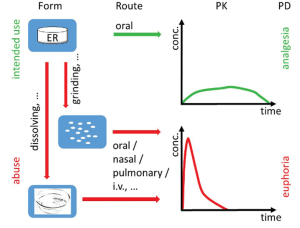
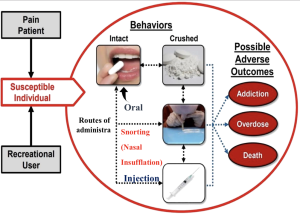
What Role Can Excipients Have In the Risk of Abuse and Diversion of Formulations?
In evaluating the role of excipients, it is useful to distinguish between solid and liquid oral pharmaceutical forms.[8] In the latter case, the most common methods of misuse are 1) direct intake of the drug from the primary container without dilution in water and/or without the use of the tools contained to dose it correctly such as droppers or syringes or dosed glasses ;[9] 2) parenteral injection, often intravenous, of a concentrated liquid formulation after withdrawal with a syringe and needle and direct injection (very dangerous due to the risk of overdose and chemical phlebitis at the injection site; 3) mixing the liquid contents of the drug with solvents non-aqueous, often with psychoactive (e.g. alcohol) or flavoring properties or which improve their solubility and therefore absorption. In these cases, the excipients that most influence the effects are the flavoring agents, which improve the palatability of the active ingredient, and which can encourage its use especially by children or predisposed subjects.
They can be of natural origin such as sucrose, sorbitol, mannitol, xylitol or synthetic.[10] Also some cosolvents, added to the formulation to increase the solubility of poorly hydrophilic APIs, which do not contain ionizable groups and which can have psychoactive effects. We recall the example of alcohols (ethanol, glycerol) and propylene glycol in oral liquid formulations of benzodiazepines.[11] However, in the case of solid formulations, such as tablets, capsules and oral granules, the methods of misuse can be: 1) frequent direct intake of high doses with normal administration methods; 2) the trituration/pulverization of the formulations and subsequent intake intranasally or, after dissolving in water, intravenously.[12] In the first case, rapidly absorbed formulations such as oro-soluble, sublingual or effervescent ones are more implicated, as the absorption of the API is very rapid.[13] In the second case, however, the subject alters the release kinetics of the API by removing the original protective film of the pharmaceutical powder and inducing its rapid absorption.[14] This results in the intake of a large bolus of API designed to be released in 12 to 24 hours and, consequently, high risk of poisoning by overdose, especially among the naïve.
Conclusions
The problem of the misuse and diversion of psychoactive and non-psychoactive medicines remains epidemiologically relevant, especially among primarily drug-addicted subjects but also in patients with an initial lawful prescription followed by pathologic behavior relating to the secondary drug addiction, especially in the case of opioids and benzodiazepines.[15] The possible role of the excipients of the formulations as a contributory cause of the problem has to date been little studied in the literature, especially due to the difficulty in obtaining scientifically objective data.[16] We can certainly state that, for liquid formulations, flavorings contribute to the pleasure of drug administration and, in predisposed subjects, they can be the first factor that favors direct intake from primary packaging without dilution; alcohols and glycols as preservatives can directly induce addiction, especially if taken in high doses.[17][18] For both liquid and solid formulations, the disintegrants, solubilizers and excipients that accelerate the dissolution of the API, favoring its absorption, can favor its abuse while the excipients to delay its release are generally more protective, if they are not crushed or chewed. It will be interesting in the future to develop excipients that prevent the incorrect handling of solid formulations, discouraging the misuse of these drugs.[19]
Download the full article as PDF here: Addiction to Psychoactive Prescription Drugs: Can the Excipients of the Formulations Play a Role?
Read the original article here
Amelia Morgillo, Edoardo Marovino. (2024). Addiction to Psychoactive Prescription Drugs: Can the Excipients of the Formulations Play a Role?. Qeios. doi:10.32388/6AE2JL.
Read more on Sorbitol here:


